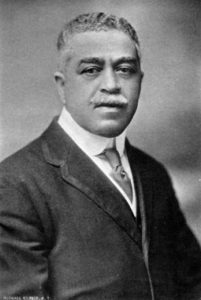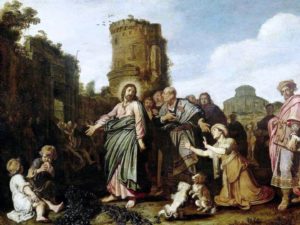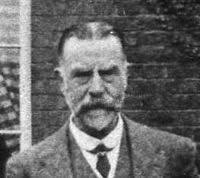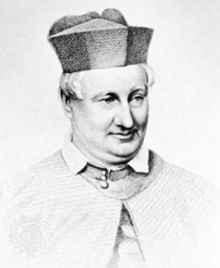“Yes, Lord; yet even the dogs under the table eat the children’s crumbs.”
Mount Calvary Church
A Roman Catholic Congregation of
The Personal Ordinariate of the Chair of St. Peter
Anglican Use
Trinity X
Hymns
In Christ, there is no east or west
There’s a wideness in God’s mercy
Jesus shall reign where’er the sun
________________________
In Christ, there is no east or west is by John Oxenham (1852—1941). Oxenham opposes Rudyard Kipling’s sentiment: “Oh, East is East, and West is West, and never the twain shall meet” from Barrack-Room Ballads, and Other Verses (1892). Paul in Galatians 3:28 proclaimed: ‘There is no longer Jew or Greek, there is no longer slave or free, there is no longer male and female; for all of you are one in Christ.’” Mount Calvary was the leading Episcopal church in Baltimore in its mission to African-American, It welcomed all as members, and sponsored two missions in Baltimore, St. Mary the Virgin and St. Katherine. St Mary the Virgin was the most prominent African-American Episcopal church in the United States, and had more communicants than Mount Calvary. Mount Calvary sponsored the first African- American seminarian at the General Theological Seminary. The Catholic vision of Mount Calvary has always included all races.
1 In Christ there is no East or West,
In Him no South or North;
But one great fellowship of love
Throughout the whole wide earth.2 In Him shall true hearts everywhere
Their high communion find;
His service is the golden cord
Close binding all mankind.3 Join hands, then, brothers of the faith,
Whate’er your race may be!
Who serves my Father as a son
Is surely kin to me.4 In Christ now meet both East and West,
In Him meet South and North;
All Christly souls are one in Him
Throughout the whole wide earth.
Here is St. John’s, Detroit.
John Oxenham (William Arthur Dunkerley)
William Arthur Dunkerley (12 November 1852 – 23 January 1941) was a prolific English journalist, novelist and poet. He was born in Manchester, spent a short time after his marriage in America before moving to Ealing, west London, where he served as deacon and teacher at the Ealing Congregational Church from the 1880s, and he then moved to Worthing in Sussex in 1922, where he became the town’s mayor.
He wrote under his own name, and also as John Oxenham for his poetry, hymn-writing, and novels. His poetry includes Bees in Amber: a little book of thoughtful verse (1913) which became a bestseller. He also wrote the poem Greatheart. He used another pseudonym, Julian Ross, for journalism. Dunkerley was a major contributor to Jerome K. Jerome’s The Idler magazine.
He had two sons and four daughters, of whom the eldest, and eldest child, Elsie Jeanette, became well known as a children’s writer, particularly through her Abbey Series of girls’ school stories. Another daughter, Erica, also used the Oxenham pen-name. The elder son, Roderic Dunkerley, had several titles published under his own name.
McKee is a tune adapted from a spiritual by the famous African-American composer and songwriter, 
Harry T. Burleigh (1866—1949).
It was named for the rector of St. George’s Episcopal Church in New York City, Elmer M. McKee, where Burleigh was the baritone soloist for over 50 years.
With the aid of a scholarship (obtained with the help of Frances MacDowell, the mother of composer Edward MacDowell), Burleigh at the age of 26 was accepted to the prestigious National Conservatory of Music in New York, eventually playing double bass in the Conservatory’s orchestra. Though at first the Conservatory denied Burleigh entrance, citing low grades, Mrs. MacDowell (the registrar) insisted that he try his entrance exam again. Days later, he received a scholarship. To help support himself there, Burleigh worked for Mrs. MacDowell as a handyman, cleaning and working on anything she needed. Reputedly, Burleigh, who later became known worldwide for his excellent baritone voice, sang spirituals while cleaning the Conservatory’s halls, which drew the attention of the conservatory’s director, Czech composer Antonín Dvořák, who asked Burleigh to sing for him. Burleigh said: “I sang our Negro songs for him very often, and before he wrote his own themes, he filled himself with the spirit of the old Spirituals.” Dvořák said: “In the negro melodies of America I discover all that is needed for a great and noble school of music.”
From what he called “Negro melodies” and Native American music, Dvořák took up the Pentatonic scale, which appears in some places in his Symphony “From the New World” and at the beginning of each movement of the “American” String Quartet. In the Symphony, a flute theme resembles the spiritual Swing Low, Sweet Chariot, which may well be among those Burleigh sang to Dvořák, and which may have been written by a Black (African-American, by descent) Native American (by legal status) Choctaw freedman, Wallis Willis.
In 1922, another student of Dvořák, William Arms Fisher, wrote the spiritual-like song “Goin’ Home” based on an English horn melody from the second movement (Largo) of the Symphony. No evidence seems to exist that the song existed before 1922, or the melody before the Symphony (1893), although both are disputed. In 1893 Burleigh assisted Dvořák in copying out instrumental parts for the symphony.
The following year, Burleigh sang in Dvořák’s arrangement of Pennsylvania native Stephen C. Foster’s classic Old Folks at Home. He graduated in 1896, and later served on the conservatory’s faculty.
In the late 1890s, he also began to publish his own arrangements of art songs. About 1898 he began to compose his own songs and by the late 1910s, Burleigh was one of America’s best-known composers of art songs. Beginning around 1910, Burleigh also worked editing music for G. Ricordi, an Italian music publisher with offices in New York.
Burleigh published several versions of the Negro spiritual “Deep River” in 1916 and 1917, and he quickly became known for his arrangements of spirituals for voice and piano; one of his arrangements in Common Metre is the hymn tune “McKee”, used with John Oxenham’s hymn “In Christ There Is No East or West”. His arrangements helped to make spirituals a popular genre for concert singers, and within a few years, many notable singers performed Burleigh’s arrangements.
Burleigh’s art song arrangements of the spiritual and other sentimental songs were so popular during the late 1910s and 1920s, that almost no vocal recitalist gave a concert in a major city without occasionally singing them.[citation needed] John McCormack sang a number of Burleigh’s songs in concert, including “Little Mother of Mine” (1917), “Dear Old Pal of Mine” (1918), “Under a Blazing Star” (1918), and “In the Great Somewhere” (1919). In many ways, the popularity of Burleigh’s settings contributed to an explosion of popularity for the genre during the 1920s. He also set some poems by Walt Whitman to music, and also published songs for piano and violin. (Wikipedia)
____________________
There’s a wideness in God’s mercy was written by Frederick Faber (1814—1863). He was born an Anglican and reared a strict Calvinist. After attending Oxford, he took orders as an Anglican priest and began his ministry as a rector. Influenced by his friend John Henry Newman (1801—1890) who converted from Anglicanism to Roman Catholicism in 1845, Faber also converted to Catholicism that same year.
1 There’s a wideness in God’s mercy,
Like the wideness of the sea:
There’s a kindness in His justice,
Which is more than liberty.2 There is welcome for the sinner,
And more graces for the good;
There is mercy with the Saviour;
There is healing in His blood.3 For the love of God is broader
Than the measure of man’s mind;
And the heart of the Eternal
Is most wonderfully kind.4 If our love were but more simple,
We should take Him at His Word;
And our lives would be all sunshine
In the presence of our Lord.
Fredrick Faber
Frederick Faber was born in 1814 at Calverley, then within the Parish of Calverley in the West Riding of Yorkshire, where his grandfather, Thomas Faber, was the vicar. His father served the local bishop of the Church of England as his secretary.
Faber attended grammar school at Bishop Auckland in County Durham for a short time, but a large portion of his boyhood was spent in Westmorland. He afterwards attended the Harrow School for five years, followed by enrollment in 1832 at Balliol College at the University of Oxford. In 1834, he obtained a scholarship at the University College, from which he graduated. In 1836 he won the Newdigate Prize for a poem on “The Knights of St John,” which elicited special praise from John Keble. Among his college friends were Arthur Penrhyn Stanley and Roundell Palmer, 1st Earl of Selborne. After graduation he was elected a fellow of the college.
Faber’s family was of Huguenot descent, and Calvinist beliefs were strongly held by them. When Faber had come to Oxford, he was exposed to the Anglo-Catholic preaching of the Oxford Movement which was beginning to develop in the Church of England. One of its most prominent proponents was the popular preacher John Henry Newman, vicar of the University Church of St Mary the Virgin. Faber struggled with these divergent forms of Christian beliefs and life. In order to relieve his tension, he would take long vacations in the Lake District, where he would write poetry. There he was befriended by another poet, William Wordsworth. He finally abandoned the Calvinistic views of his youth and became an enthusiastic follower of Newman.
Faber was ordained in the Church of England in 1839, after which he spent time supporting himself as a tutor. In 1841 a travelling tutorship took him to the continent; on his return he published a book called Sights and Thoughts in Foreign Churches and among Foreign Peoples (London, 1842), with a dedication to his friend, the poet Wordsworth.
In 1843, Faber accepted the position of rector at a church in Elton, then in Huntingdonshire but now in Cambridgeshire. His first act was to go to Rome to learn how best to carry out his pastoral charge. Faber introduced the Catholic practices of celebrating feast days, confession and the devotion of the Sacred Heart to the congregation. However, there was a strong Methodist presence in the parish and the Dissidents packed his church each Sunday in an attempt to challenge the Roman Catholic direction he was taking the congregation in. Many of his parishioners were reputed to be living in de facto relationships and the village was notorious for its double standards. He developed the thought of following a monastic way of life and was joined by several men with whom he formed a small community at the rectory.
Faber caused a small furore through his publication of a Life of St. Wilfrid, in which he supported the claim of primacy by the pope. Nonetheless he was accepted by the people of the parish.
Few people were surprised though when, after prolonged mental struggle, Faber left Elton to follow his hero Newman and join the Catholic Church, into which he was received in November 1845 by Bishop William Wareing of Northampton. He was accompanied in this step by eleven men of the small community which had formed around him in Elton. They settled in Birmingham, where they informally organized themselves in a religious community, calling themselves the Brothers of the Will of God.
Faber and his small religious community were encouraged in their venture by the Earl of Shrewsbury, who gave them the use of Cotton Hall in Staffordshire. Within weeks they had begun construction on a new Church of St. Wilfrid, their patron saint, designed by the noted church architect, Pugin, as well as on a school for the local children. All of this was for a region which had no other Catholics at that point, other than the household of the Earl. The exertions took their toll on Faber, who became so ill that he was not expected to live and was given the Last Rites of the Church. He recovered, however, and was ordained a Catholic priest, celebrating his First Mass on 4 April 1847. In the course of his illness Faber had developed a strong devotion to the Blessed Mother. Prompted by this devotion, he translated St. Louis de Montfort’s classic work, True Devotion to Mary, into English.
Along with Newman, Faber felt drawn to the way of life of the Oratory of St Philip Neri, with its decentralized authority and greater freedom of life than in religious institutes. His interest was heightened when he learned that Newman himself had become an Oratorian while in Italy. Faber envisioned having his community at Cotton Hall form a new community of the Oratory, with Newman as Superior. However, this could not happen at Cotton Hall since the Oratorian rules required that they be an urban community.
The Earl, who had handsomely financed the construction of a new parish for the community, felt betrayed by such a quick departure. Additionally, the Wilfridians, as the Brothers were called, wished to wear a traditional religious habit, upsetting the old Catholic families who had survived centuries of persecution by keeping a low profile. Newman thus proposed that Faber’s community settle somewhere other than Birmingham, and suggested London as the best option. Thus in 1849 a community of the Oratory was established in London in William IV Street.
On 11 October 1850, the feast of St. Wilfrid, the community in London was established as autonomous, and Faber was elected its first provost, an office he held until his death. He took ill again, however, almost immediately, and was ordered by his physicians to travel to a warmer climate. He attempted a trip to the Holy Land but had to turn back, and instead toured Malta and Italy. The community still lacked a permanent home, and in September 1852 a location was chosen at Brompton. The Oratorians proceeded with construction despite public protests at their presence.
Faber had never enjoyed good health. He had suffered from illness for years, developing what was eventually diagnosed as Bright’s Disease, which was to prove fatal. In spite of his weak health, much work was crowded into those years. He published a number of theological works, and edited the Oratorian Lives of the Saints.
Faber died in 1863 and was buried in the Oratorian cemetery in Rednal, in the West Midlands.
Father Faber was the great-uncle of Geoffrey Faber, co-founder of the publishing house “Faber and Gwyer” which later became “Faber and Faber”, a major publisher of both literary and religious works.
_________________
Jesus shall reign where’er the sun is by Isaac Watts (1674—1748). In 1719, Watts published a hymnal entitled The Psalms of David, Imitated. In this hymnal, he paraphrased many of the Psalms, but in a very different style than many of his predecessors. The custom of the day was to keep any paraphrase as close to the text as possible. Watts decided to do otherwise, and his interpretations of the psalms are quite loose, in an effort to write something new while keeping the spirit of the Psalm. His versification of Psalm 72 is no different. He interprets the psalm using a Christological lens. The king referenced in the psalm is Christ, and could be no one else. For Watts, as for the Fathers of the Church, the Old Testament makes sense in light of the New, and vice versa.
1 Jesus shall reign where’er the sun
does his successive journeys run;
his kingdom stretch from shore to shore,
till moons shall wax and wane no more.2 People and realms of every tongue
dwell on his love with sweetest song,
and infant voices shall proclaim
their early blessings on his name.3 Blessings abound where’er he reigns:
the prisoner leaps to lose his chains;
the weary find eternal rest,
and all the sons of want are blest.4 To him shall endless prayer be made,
and praises throng to crown his head;
his name like incense shall arise
with every morning sacrifice.5 Let every creature rise and bring
peculiar honours to our King;
angels descend with songs again,
and earth repeat the loud Amen.
Here are Nebraskans singing. Here are Koreans. Here are Yorkshiremen. And the Hong Kong Hymn Society.


